Or the amazing collaborative effort to give us a dog's perspective in Hawkeye #11
By Matt Fraction, David Aja, and Matt Hollingsworth, Marvel Comics
Hawkeye #11 is a comic about Lucky aka Pizza Dog, the loveable animal sidekick of Clint Barton and pizza affectionado, solving a murder. Pizza Dog is the star of this comic and the entire issue is written from the dog's perspective. It is, frankly, an amazing comic with the fun gimmick of starring Lucky.
There are going to *SPOILERS* here, so do yourself a favour and read the damned book if you haven't yet.
Let me first state a pretty dramatic bias here: I love dogs. I grew up with them, and my currently family thing contains one small four legged canine creature. His name is Marls T Barkley, although I frequently tell people his name is Steven Google (because it is hilarious). My partner and I would have more dogs if not for finances and an apartment with a one dog rule. These hypothetical additional dogs would be named for Law and Order characters and Noble prize winning Biochemists and one of which would be a Chip-it (or Whihuahua if that's your preference). What I am trying to say here is that I would enjoy a comic about a dog solving crimes pretty much guaranteed and that I am an extraordinarily cheap date for this comic.
That said, this comic is fucking incredible.
Like, no joke, one of the best, most unoprthodox single issues of a comic that I have ever read. Like Apollo 11, but with dogs. Which makes it better. It's remarkable in any number of ways.
But, beyond simply gushing, I think this issue does an astounding job of conveying the perspective of a dog. Team Hawkguy does makes some really smart, innovative choices to really sell the story's central gimmick. And I would like to highlight some of them for you.
Dialogue: Hawkeye #11 is largely without dialogue, since dogs cannot really understand human speech, and cannot speak themselves (the Speak! trick does not count). Instead the majority of the story telling relies on body language, posture, and visual info-graphics to convey the narrative. What human dialogue the comic does feature is garbled and hand written with only certain, simple words a dog might recognize being legible. All of this is just such a smart, instant way to establish the comic as being from Lucky's perspective.
Perspective: Probably the most obvious and subtle dogiffying choices of the comic is one of perspective. While most comics alternate between torso/head close-ups for emoting and wider view establishing shots for setting and action, Hawkeye #11 sets its sights a little lower. Dog height to be specific. Basically, Hawkguy #11 is a comic with a viewpoint shifted about three feet lower than most. As a result, we see more legs, ankles, and shoes in this comic than any other comic I can remember and we get a narrative perspective much more canine than human. It's subtle, but again, the change in perspective really helps cement the difference in viewpoint character.
Body Language: If you have spent any time around dogs, especially groups of dogs, you know that body language is super important to them. Dogs communicate with one another through posture, tail position, and probably even facial expressions a little bit. Hawkeye #11, does an amazing job or portraying dogs that look, and act like dogs. I mean, there is some anthropomorphizing (the salute, for instance) for storytelling reasons, but there is also a lot of dogs looking and acting like dogs. And it really made the comic work for me.
Colouring: Another very subtle tweak that helps cement Lucky as our viewpoint character is one of colour. Dogs, as you no doubt know, are colour blind. Now, this doesn't mean that they do not see colour at all, but rather that they probably perceive the world like a colour blind human. Let me explain, humans have coloured light sensing cells in the retina called cones. In "normal" humans these cones express some combination of three colour sensitive proteins that allow the eye to distinguish Red, Green, and Blue light. This is called "Trichromatic Vision". Because some of these colour sensitive proteins (opsins) are encoded by genes on the X-chromosome, mutations in these genes cause a percentage of men (between 2 and 10%), to be unable to distinguish the difference between Red and Green. These colour blind humans have "dichromatic vision" that essentially sees things mostly in shades of Blue and Yellow. (Some women, may actually have "tetrachromatic vision" because of crazy X-chromosome genetics... but that's still kind of up-in-the-air). Dogs, like colour blind humans, have "dichromatic vision" and are generally considered to be Red-Green colour blind. As such, it is thought they also see the world in shades of Blue and Yellow. (</Science Talk>.) It is super subtle, but the colours in Hawkeye #11 are skewed away from Green and Red and heavily feature Yellow and Blue. It's kind of hard to see unless you hold up a previous Matt Hollingsworth coloured issue and compare, but all of the Purple's are now Blue for instance. Even the Tracksuit Draculas, the one Red thing in the issue, are a more muted, grey/brown red than in previous issues. Essentially, Hawkguy #11 is coloured as a dog would see the world and this is a super, super, subtle decision is just absolutely brilliant. If ever you need proof that colouring is an essential component of a finished comic this is it.
Senses: Dogs have kind of crappy vision, but like Daredevil this weakness is compensated for by their amazing other senses. Compared to humans dogs have much more sensitive senses of smell and hearing. And, as a result, the way dogs interpret the world is much more dependent on these senses than they are for humans. Of course, this presents a challenges to the comic medium. How do you convey intangible senses like scent visually? How do you show the importance of sound without having sound effects everywhere? Team Hawkguy solves this problem in a really effective, really smart way. What they do is to build this information into infographics which visually represents how important these elements are to Lucky's interpretation of events. It is absolutely brilliant comics.
Internal Dialogue: Much of comic story telling is dependent on the thoughts/narration of the characters as they interpret the narrative. Now for humans this is pretty straightforward, people think in language. As such, narrative captions and thought ballons can have a person going "These are abusive jerks". Dogs do not have a faculty for language and therefore can't have a language based internal monologue. It is instead thought that dogs think more in a image/concept way since they do not have a language to construct their thoughts around. Team hawkguy brilliantly uses infographics formatted in this image/concept format to convey Lucky's internal monlogue without resorting to words. It's pretty great stuff.
So, Hawkguy #11 is a brilliant example of collaborative synergy creating a comic that manages to let is audience experience life as a crime-solvin' Pizza Dog. It is absolutely fantastic.
Previously:



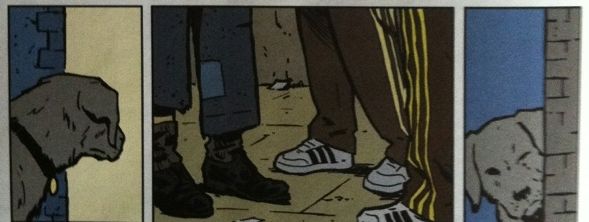
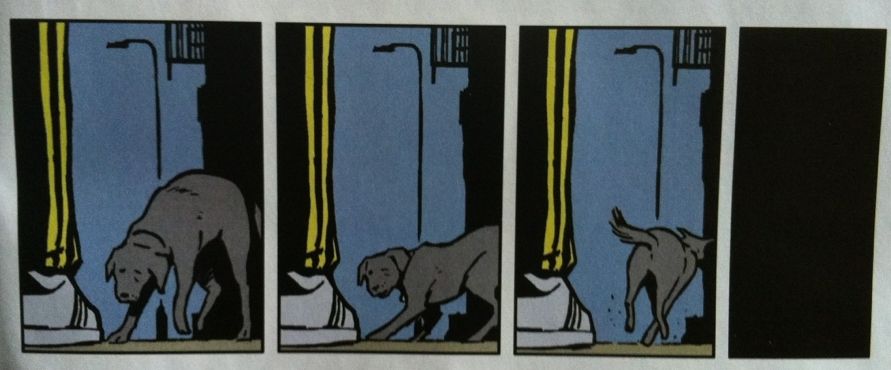
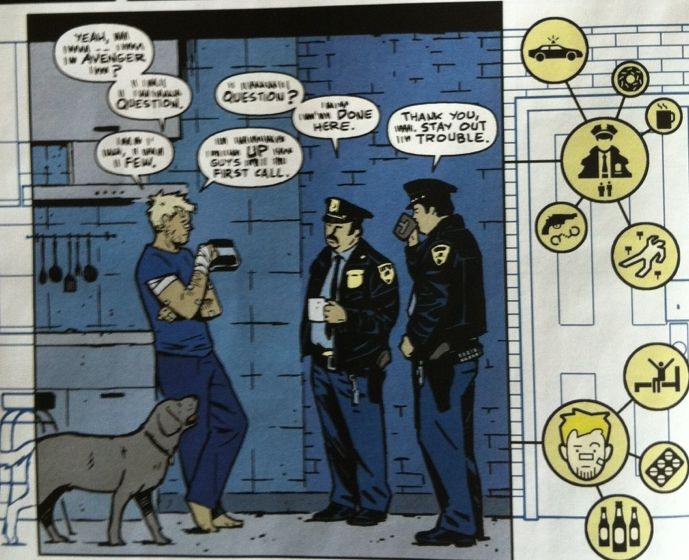


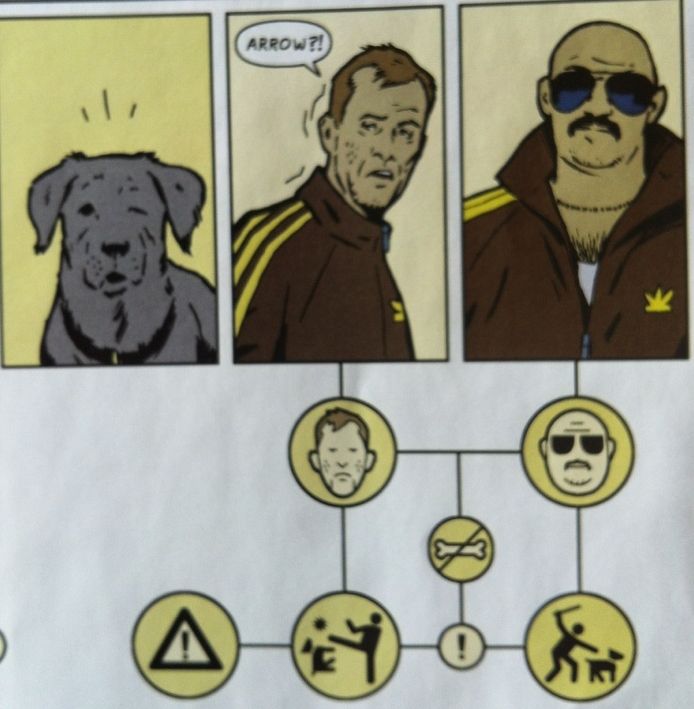
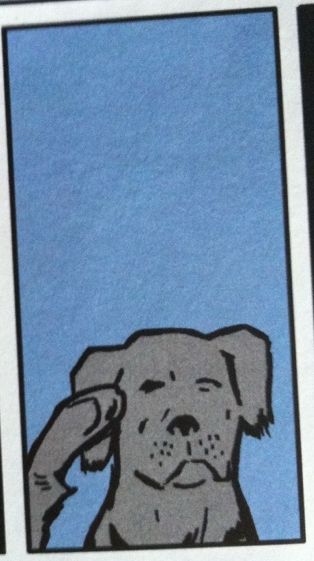
No comments:
Post a Comment